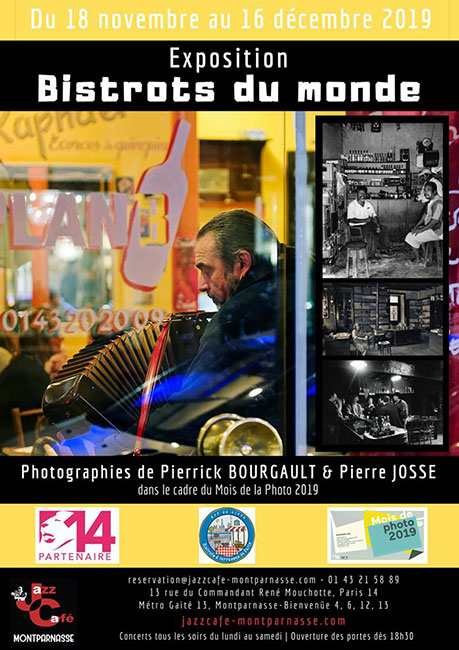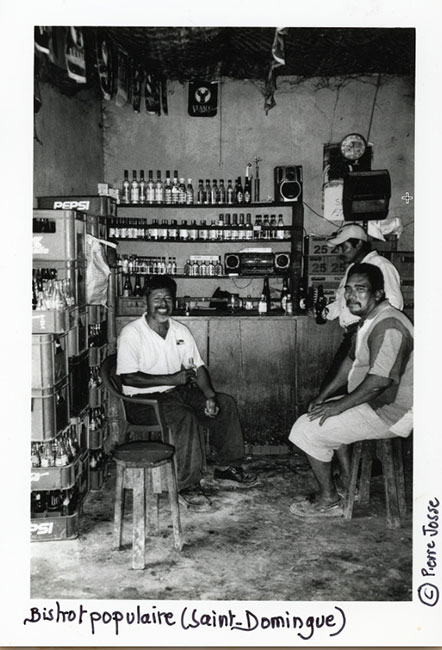Posted on December 3, 2019 in Arts & culture, Life Style.
Pierre Josse and the Bistros of the world
Pierre Josse (editor-in-chief of the Routard guides) and Pierrick Bourgault present at the Jazz Café Montparnasse (14th) as part of the Mois de la Photographie in Paris until December 16, the exhibition “Bistrots du monde” who are interested to all places of conviviality on the planet.
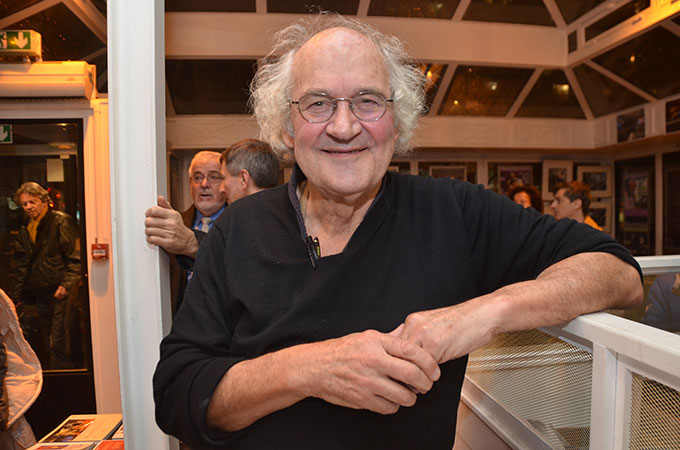
“I have told a lot of anecdotes which are linked to things that I have experienced in pubs in Ireland” explains Pierre Josse. - © David Raynal
For Pierre Josse, professional vagabond (editor in chief of the Routard guides), this exhibition of photographs is an opportunity to offer recognition, a place of honor in these places essential to the proper functioning of our society. Without the cafes that bring together and strengthen solidarity, men's lives would dramatically unravel ...
For his part, Pierrick Bourgault, tells and photographs the cafes and bistros of the world. He likes to listen, observe and describe with the light of the place and the moment, to show the universe of a person, a group. Combining this taste for words and bistros, he organizes a concert of French-speaking songs every Monday at the Jazz Café Montparnasse.
Both are authors of numerous works, presented during this exhibition, and members of the Association for the inscription in the intangible heritage of Unesco of Bistros and Terraces of Paris for their art of living. Meet Pierre Josse, a backpacker with a big heart who displays more than a hundred countries visited at the counter…
On the occasion of this exhibition devoted to "bistros of the world" can you tell us about your photographic approach?
“My photographic approach consists in remembering moments and emotions that I know will never reappear again. All my life, I have wanted, in a very modest way, to be the memory of things which are brought to disappear, especially if they have a cultural, sociological or human significance.
With this exhibition on bistros around the world, my objective was to express by photo, more than by writing, the atmosphere and the variety, of these coffees of the world. What unites them, namely mainly, the existence of these places of exchange without distinction of classes. Spaces, where you can share your solitude, find your fellow humans and sometimes even a reason to live collectively. But I also wanted to show at the same time what separates them, the geographical parameters, the diversity of cities and traditions. I just wanted to convey the emotions I experienced in these bistros, and try to share with black and white photos, the great bistro culture.
Black and white are for me the true colors of nostalgia. There are some very beautiful things in color, but it diverts a bit from the poetry of situations and places. On the other hand, my partner on this exhibition, Pierrick Bourgault, offers precisely color shots for a real dynamic and a beautiful complementarity between our two approaches. "
All these bars do not have the same customs or habits, the same way of approaching customers. Is it the same to go to a bistro in Japan or in Ireland?
“It's an adventure to go to a bistro in Japan. In Tokyo, a lot of establishments are very small. I even found the smallest bistro in the world there. I am not talking about a table that you put on the street with a coffee maker and a few cups. No, a real bistro in a building, 4 m²! With the boss behind the counter, there can be seven customers and the eighth is found in the doorframe. It's interesting, because it's an old neighborhood clientele.
These bistros are a historical heritage. They were created during the reconstruction of Tokyo after 1945. Hundreds of thousands of workers worked on the construction sites and they needed small canteens, places to rest, relax and eat.
As these Japanese pubs were close to the railways, the land was not buildable or unattractive. With the real estate speculation which rages in the big megalopolises, it is almost a miracle that they have survived until now. One of the traditions of these little bistros is, for example, to refuse foreigners. Not by xenophobia, but simply because when you only have seven customers in the room, there is a good chance that they are only regulars.
If the tourists arrive in droves and occupy these small bistros, the usual customers will probably desert the place and their owners risk in the long term losing their customers and closing shop. But it must be said that things are changing little by little and that these pocket bars are starting to open up a little more. "
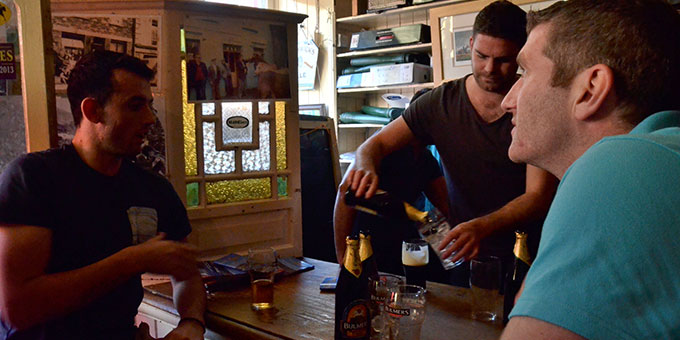
© David Raynal
Is alcohol consumption a sine qua non for going to the bistro?
“It's true that the bistro is more associated with the euphoria of alcohol. Some people need a small dose of alcohol in order to disinhibit themselves. The shy one will finally embolden himself and speak for the first time to the young girl he has coveted for two years on the other side of the counter. Obviously it helps and connects people. And when there is excess, the boss is there. He is the keeper of the lighthouse, of harmony. He is a tension reducer, he will know how to find the words and possibly the blackjack, if really the type is too threatening to calm things down and call for reason.
There are rituals that can be found around the world. This organic relationship between the boss and his clientele so that the bistro remains a place of exchange and communication. A place where collectively, we stick together and try to get out of our anxieties or misery.
Why people went to the bar at the beginning of the 20e century? Mainly because the accommodations were very poorly heated. Ditto for the telephone. You have to remember that in the 50s, you had to wait at least two years to have a landline at home. The bistro almost responded to a notion of service. Conversely, there are also countries where there are bistros in which no alcohol is drunk. This is the case with Yemen, where you can still drink the best coffee in the world.
In spite of the more or less strict observance of the Muslim religion, there are openings which are made, I think of the famous Fishawy cafe in Cairo, inside which more and more women come to sit down to smoke. the shisha. Attendance is therefore not necessarily linked to alcohol in this case. It is only a matter of being well together collectively. "
Is it true that the word bistro comes from Russian, bistro, which means fast?
“The word would indeed come from the Russian быстро, bistro“ quickly ”. It is the Cossacks, stationed in Paris in 1814 at the end of the Napoleonic wars who would have used it to apostrophize the cafetiers. It should be remembered that at the same time, there was the tour of the Grand Dukes. We are still in 1814 and the Grand Dukes were the high ranking officers of the Russian army who were going to party in Paris. At the time, it was a question of drinking like a Cossack! "
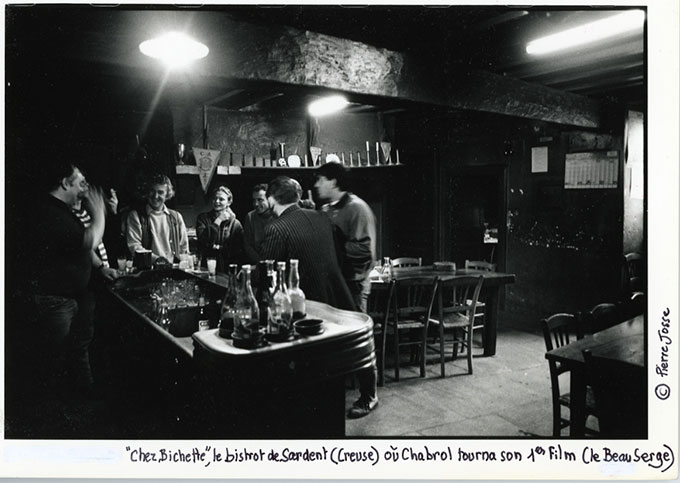
© Pierre Josse
Is there a bistro vocabulary in each country?
“I am not a doctor of bistro for all the countries of the world. But what is certain is that bars are places for free speech. We can let go, tell three-ball jokes with great indulgence on the part of the audience. In Ireland, these are not news stories like in France, but anecdotes linked to history and tumultuous relations with the United Kingdom.
In this country, a lot of songs have left the bars. For a long time the peasants could not read. The transmission was done by storytellers and traveling singers who walked with their bagpipes from bars to bars. During the great revolt of 1798, the news was transmitted through the singers. And it is no coincidence that as soon as a singer was taken, he was hung from a tree with his bagpipe. "
How was the choice of images made for this exhibition?
“In my case, these are favorites. Each image represents an experience that I had in the bistros. For example, one day I was walking in Limoges with some friends and I asked them if they could point me to a nice bar where I could take pictures.
At the time, I was preparing my first book on bistros around the world. They tell me, listen, not far from 80 km away in Sardent, there is a very interesting establishment since this is where Claude Chabrol made his first film. It was Beau Serge with Gérard Blain, Jean-Claude Brialy and Bernadette Lafont. The photo by itself does not tell the story that I lived there. But I try to express through the image what a country bistro is.
That day was Sunday at noon. The hunters took a break in the middle of the day. There is this swarm of hunters around a magnificent, undulating counter that the Americans have tried to buy several times for 5 or 10 dollars. The boss always refused. There is also Madame Germaine, who ran a café-haberdashery in Concoret in Morbihan. "
Are not the real bistros at the Doisneau going to disappear?
“There are indeed terrible figures. In 1960, in France, there were 200 bistros. Today, there are just under 000. It is mainly the country bistros that are disappearing.
However, when a village bistro disappears, very often concomitantly the school closes. It's a tragedy, let's not be afraid of words. It's the same thing in urban centers. The sociological evolutions in the districts mean that there are new habits that do not really go in the direction of conviviality. Starbucks for example are not bistros for me. Likewise, Indiana Cafes ask you to pay when you get the drink.
In some so-called “trendy” cafes, large arms are at the entrance to select customers. This jeopardizes the philosophy of the place, even when the bistro is taken over by a new owner who does not distort its atmosphere.
There is also another danger lurking. In some neighborhoods like Saint-Germain-des-Prés or Saint-Michel, counters are disappearing in favor of tables which allow the owner to charge customers twice as much for their drinks. In these establishments, it is only the cash drawer that counts. There is therefore real danger in the bottle. "
What are the criteria for there to be a bistro?
“First of all, I must point out that we have created an association to include the intangible world heritage of humanity by Unesco, the art of living in Parisian bistros and terraces. However, I am not kidding myself. In a century, the bistro as we love it may no longer exist. But in the meantime, we can delay the deadline and allow our children to experience the same joys as we do.
The bistro is first and foremost a place to relax. We fight against melancholy, neurasthenia, the blues. The boss is very often a form of psychoanalyst, even a little rustic or rudimentary. And whether we like it or not, the bistro has saved a lot of people from suicide. "
Which bistros will forever remain etched in your backpacker's memory?
“I had the chance to know the mythical“ Vin des Rues ”, rue Boulard (14e), long frequented by photographer Robert Doisneau and led with an iron fist by his dreaded boss Jean Chanrion.
Madame Paulo's “Le P'tit Bar”, which was rue Richard-Lenoir (11e). One of the most dirty bistros in Paris, but with an absolutely extraordinary atmosphere.
I am also thinking of Sampiero Corso, rue de l'Amiral Roussin in 15e. A Corsican who had made international brigades. It was a bistro, but also a restaurant where you paid according to your means, free for the unemployed, the retired and workers on strike. A bit like the Bolshevik ancestor of Restos du Coeur.
There are indeed a number of addresses that remain in our memories and that we will never forget. "
Interview by David RAYNAL
To find out more about the association, bistros and terraces in Paris for their inclusion in UNESCO's intangible heritage.
Free membership and subscription of 3 €. Among the next actions, the association will soon launch a written petition to give more force to this campaign of support and sustainability of neighborhood bistros in Paris and in major cities.
https://www.facebook.com/bistrotsetterrassesdeparis/
The “Bistrots du monde” exhibition is visible in free access every day until December 16, 2019 except Sunday, from 18 pm to 30 pm.
Jazz Cafe Montparnasse
13 rue du Commandant René Mouchotte, 75014 Paris
https://jazzcafe-montparnasse.com
Read also:
- Wandering Chronicles, small dictionary of the unusual routes of a Routard - Hachette Tourisme -2017.
- La Nostalgie is behind the counter of Pierre Josse and Bernard Pouchèle - Fleurus -1999.
- Two vagabonds in Ireland by Pierre Josse and Bernard Pouchèle - Terre de Brume - 1998.
- The echo of the bistros, little confidence on the cafes, pubs, taverns and other taverns of Pierrick Bourgault - Transboréal -2012.
- Bars en France by Pierrick Bourgault - Dakota Editions -2009.
- Les Zinzins du zinc, guide to the best wine bars in France by Pierrick Bourgault and Egmont Labadie - Fleurus - 2007.
To read our other interview by Pierre Josse:
Drawing Now Art Fair: Tatiana Wolska winner 2024
The invention of language by Gertrude Stein and Pablo Picasso
The history of French women's golf at Golf du Sorbier






